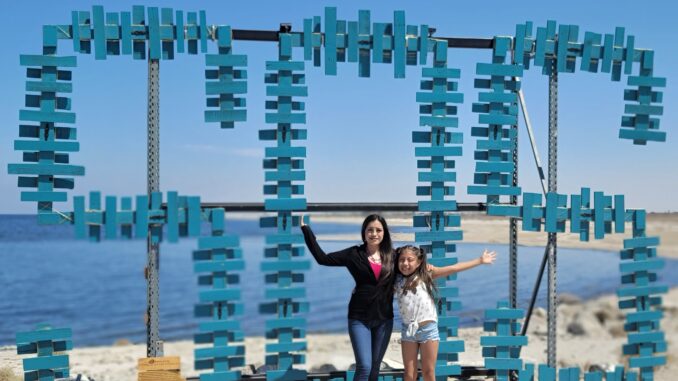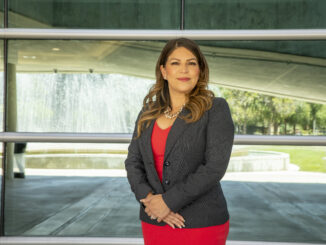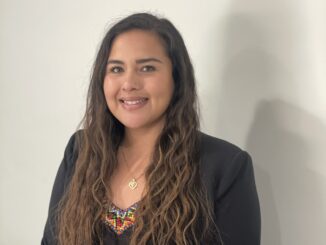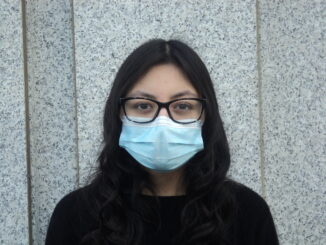
by Edgar Sanchez
In late 2019, Ana Yaretzi Garcia heard the news: A public hearing on air quality—a critical issue for her—would be held in Sacramento.
To Ana, then 6, it didn’t matter that California’s capital was 545 miles from her Salton City home in Imperial County. She had to be at the meeting, no matter how far it was. She asked her parents to drive her.
And that’s how Ana came to speak about the horrible air pollution associated with the dying Salton Sea, California’s biggest lake, at a December 2019 hearing of the California Air Resources Board in Sacramento. Her testimony is part of the reason that, in 2022, the state prioritized addressing this ecological crisis.
Among other things, Ana told CARB that Salton City’s air is so bad, she and her friends often cannot go out.
“The air has bacteria and it sickens us,” Ana says, noting that she and many neighbors have allergic reactions to fetid airborne toxins emanating from the landlocked Salton Sea a few miles away.
“When my husband and I bought our home in Salton City, we didn’t know these problems existed.”
Amor Garcia
Mother and air quality advocate
With twice the surface area of Lake Tahoe, the Salton Sea was created in 1905 by accident: An irrigation canal that carried water from the Colorado River shattered, sending water into a low-lying area known as the Salton Sink. According to historians, the river flowed unimpeded for 18 months into the sink. The new lake eventually became 15 miles wide and 45 miles long, providing water for agriculture.
In the mid-20th century, the sparkling Salton Sea drew countless tourists. Runoff from farms kept the lake full, but also polluted it with chemicals. By the 1970s, the lake began to shrink and the pollution condensed, causing bird and fish die-offs. Over decades, the problems worsened and tourists disappeared.
As the Salton Sea recedes, its crumbling lake bed has turned to dry dust—dust that on windy days swirls for miles in the surrounding desert.
Ana, who will turn 9 in August, was healthy when her family moved in May 2016 to Salton City, a town of about 6,000 residents. Shortly afterwards, she began to experience severe allergy symptoms; her eyes swelled and watered, and she had flu-like nasal congestion. Later, her bronze skin turned pale.
Amor Garcia, Ana’s mother, did not know what caused her daughter’s symptoms. “I became sad and disconcerted,” Garcia says.
Ana, it turned out, wasn’t alone. When she began kindergarten in 2017 at Salton City’s Sea View Elementary School, many of her classmates had the same, or worse, symptoms. Other parents—and doctors who examined Ana—cited the Salton Sea as the cause.
Ana’s mother was stunned. “When my husband and I bought our home in Salton City, we didn’t know these problems existed,” Garcia says.
For now, she and her husband, Juan, cannot relocate. Owners of a small business, they are anchored to Salton City. They also lack funds to move.
But after discovering the cause of her daughter’s illness, Amor Garcia joined parent activists demanding that the Coachella Valley Water District and other agencies launch a concerted effort against the Salton Sea-related illnesses.
“Amor is committed to being an agent of change for improving the health” of all Salton City residents, says Anna Lisa Vargas, an environmental justice advocate with Communities for a New California Education Fund.
At the 2019 meeting, CARB heard public comments regarding AB 617, which created California’s Community Air Protection Program, or CAPP.
At that hearing, Garcia echoed her daughter, pleading for CARB to alleviate Salton City’s air nightmare. After listening to them and other speakers, CARB added the Eastern Coachella Valley into the program. As a result, local authorities are developing mitigation strategies to help improve air quality in the region, including the Salton Sea Air Basin.
Besides the efforts prompted by AB 617, which was co-authored by Assemblymember Eduardo Garcia (D-Coachella), federal agencies also have vowed to help cleanse the Salton Sea.
Ana and Amor Garcia helped their community to hopefully breathe easier in the future, all because a young girl decided to speak up and make herself heard.




